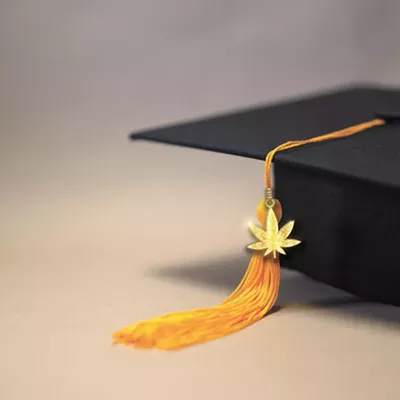Fifty-one drums made of elk hide and 50 garments hang from a wall and ceiling inside Washington State University's Jordan Schnitzer Museum of Art. Screen-printed on just a few of the technicolor drums and garments are the following phrases: "She Speaks Up to Take Them Down," "He Imagines a Future" and "They Protect the Land."
The drums and garments are part of "To Name An Other," a collective work by Cherokee-Choctaw artist Jeffrey Gibson and the centerpiece of an ongoing exhibition of his art showing until March 9, 2024, at the Pullman museum. The exhibition is titled "They Teach Love," another phrase printed on a drum and garment in "To Name An Other."
This year, Gibson is representing the U.S. at the 2024 Venice Biennale, the oldest biannual international exhibition. Ryan Hardesty, the Schnitzer museum executive director and "They Teach Love" curator, says Gibson's art is about creating community and a welcoming spirit uniting people of all identities.
"I really believe that separation, whether it's gender or nationhood or religion, doesn't serve us in any way. These are all problems that are impacting us equally across the globe, and we all need to come together, and we also need to give everybody the opportunity to contribute," Gibson says. "To me that's not dark because I do believe it's completely in our power to do that."
Curated from the art collection of museum benefactor Jordan Schnitzer and his family foundation, "They Teach Love" includes 35 works from a roughly 15-year period of Gibson's career, the earliest work being from 2008 and the most recent from this year.
These range from "SKOOKUM," a painting incorporating items from Gibson's personal collection of vintage items, to "ALL I EVER WANTED ALL I EVER NEEDED," a canvas punching bag covered in beads, sinew, studs and paint.
Through multimedia art, Gibson combines his Cherokee-Choctaw heritage with modernism and popular, contemporary culture, according to a press release.
"When I go into the studio, it's really just play," Gibson said in a recorded guided discussion museumgoers can listen to. "It's a building that's filled with materials, it's filled with fashion magazines, art books, anthropologic collection books, videos, movies, everything, and so all of it just kind of fuses through me and then I just play with it."
Although "They Teach Love" is a somewhat retrospective exhibition, Gibson's work is not displayed in chronological order, Hardesty says. Instead, the museum took a more thematic approach to the exhibition's layout.
"They Teach Love" begins in the foremost gallery with Gibson's first prints; continues with photographs, paintings and sculptures; and ends in the backmost galleries with "To Name An Other" and other works involving fashion, installation art, performance art and film.
"We really wanted to choose works that could speak to [Gibson's] career in terms of the different themes and material types he's moved through, and recognizing that he started as a painter ... that he had early experiences with printmaking," Hardesty says. "But that he moved into more performance and working with community and in communities, that then connects to the textile work with the quilts, the banners and then the wearable garments."
Gibson started making wearable art like the garments in "To Name An Other" after a point of frustration, Hardesty says. In his experience visiting and working at museums, Gibson saw many Indigenous cultural materials taken from their communities, from their function as ritualistic or celebratory objects, and put in cases.
As one of these institutions, the Jordan Schnitzer Museum of Art can always do better, Hardesty says. Artists like Gibson push museums to progress in telling stories and working with Indigenous and other communities.
"When I make things, I really don't think of them as cultural preservation," Gibson says in the recording. "That's why I never let anyone describe my work as ceremonial or sacred or any of those things. They're really meant to exist as stand-alone artworks and in the context of artwork."
Both of Gibson's parents grew up in the 1950s and '60s in conservative Southern communities, he says. They had extreme experiences with racism and raised Gibson to acknowledge racism and homophobia, as well as that people might not give Gibson opportunities because of his queer Indigenous identity.
However, Gibson says his father always told him to "keep pushing" and "keep showing up" for what was important to him, making Gibson feel responsible for his own determination.
"If your vision is large enough for you to fight for, then it's easier to continue fighting. And if it feels like something that you're like, 'This is too much, I need to walk away,' maybe your vision's not big enough," Gibson said in the recording. "For me, I think thinking about larger conversations around Indigenous representation, Indigenous inclusion, those histories and how to think about them in a contemporary context, that became the bigger vision for me that is worth working really hard for." ♦
They Teach Love • Through March 9, 2024, open Tue-Sat from 10 am-4 pm • Jordan Schnitzer Museum of Art • 1535 N.E. Wilson Rd., Pullman • museum.wsu.edu • 509-335-1910



















